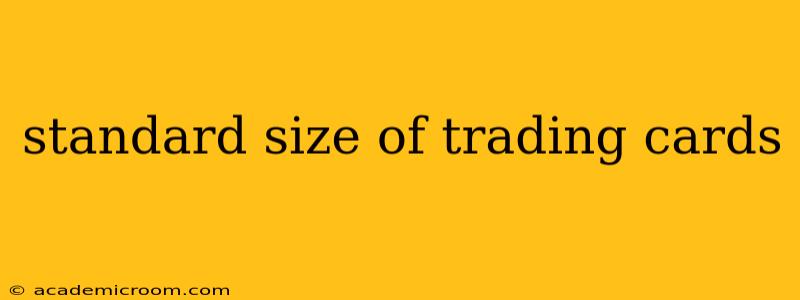Trading cards, those little pieces of cardboard that hold so much value and nostalgia, come in a variety of sizes, but there's a standard that most adhere to. Understanding this standard size is crucial for collectors, sellers, and anyone interested in the world of trading cards. This guide will delve into the standard dimensions, variations, and other important details.
What are the standard dimensions of a trading card?
The most common and widely accepted standard size for trading cards is 2.5 inches wide by 3.5 inches tall (63.5 mm x 88.9 mm). This size is used by the majority of major trading card companies, including but not limited to, Topps, Panini, and Upper Deck. This consistency allows for easy storage, organization, and display in standard-sized binders and cases.
Are there any variations in trading card sizes?
While the 2.5" x 3.5" size is the dominant standard, some variations exist. These variations are less common and often specific to certain brands, sets, or promotional releases. You might encounter cards that are slightly larger or smaller, but these deviations are usually minimal. For example, some older sets or certain insert cards might deviate slightly from this standard. However, for the vast majority of modern trading cards, sticking with the 2.5" x 3.5" measurement is safe.
What about oversized trading cards?
Oversized trading cards, often used for promotional purposes or special insert cards within a set, are a notable exception to the standard. These cards can be significantly larger, sometimes even twice the standard size. These cards are usually clearly labeled or marked as such and are generally collected and stored separately due to their larger size.
How important is the size for card grading?
Card size is a crucial factor considered by professional grading companies like PSA and Beckett. While minor variations are usually tolerated, significant deviations from the standard size can negatively impact a card's grade. Deviations in size often point to damage or alterations, leading to lower grades and reducing the card's value.
What are the different types of trading cards?
The world of trading cards is diverse, encompassing various types, including but not limited to:
- Sports cards: Featuring athletes from various sports.
- Gaming cards: Based on popular video games or tabletop games.
- Non-sport cards: Featuring celebrities, pop culture icons, or other non-athletic figures.
- Anime and manga cards: Representing characters and scenes from popular Japanese animation and comics.
- Trading card games (TCG): Cards designed for gameplay, often with strategic elements and collectible aspects.
Understanding the standard size helps in organizing and storing these diverse types of cards effectively.
Why is the standard size important for collectors?
The standard size is essential for collectors for several reasons:
- Storage: Standard-sized cards fit neatly into protectors, binders, and storage boxes designed for this specific size.
- Organization: Consistent sizing makes it easier to organize and catalog collections.
- Display: Displays and cases are generally designed to accommodate standard-sized cards.
- Value: Cards adhering to the standard size generally retain better value compared to those with significant size variations, assuming equal condition.
By understanding the standard size of trading cards, collectors can better manage, protect, and appreciate their valuable collections. The 2.5" x 3.5" standard is a cornerstone of the trading card world, ensuring consistency and facilitating the enjoyment of this popular hobby.
